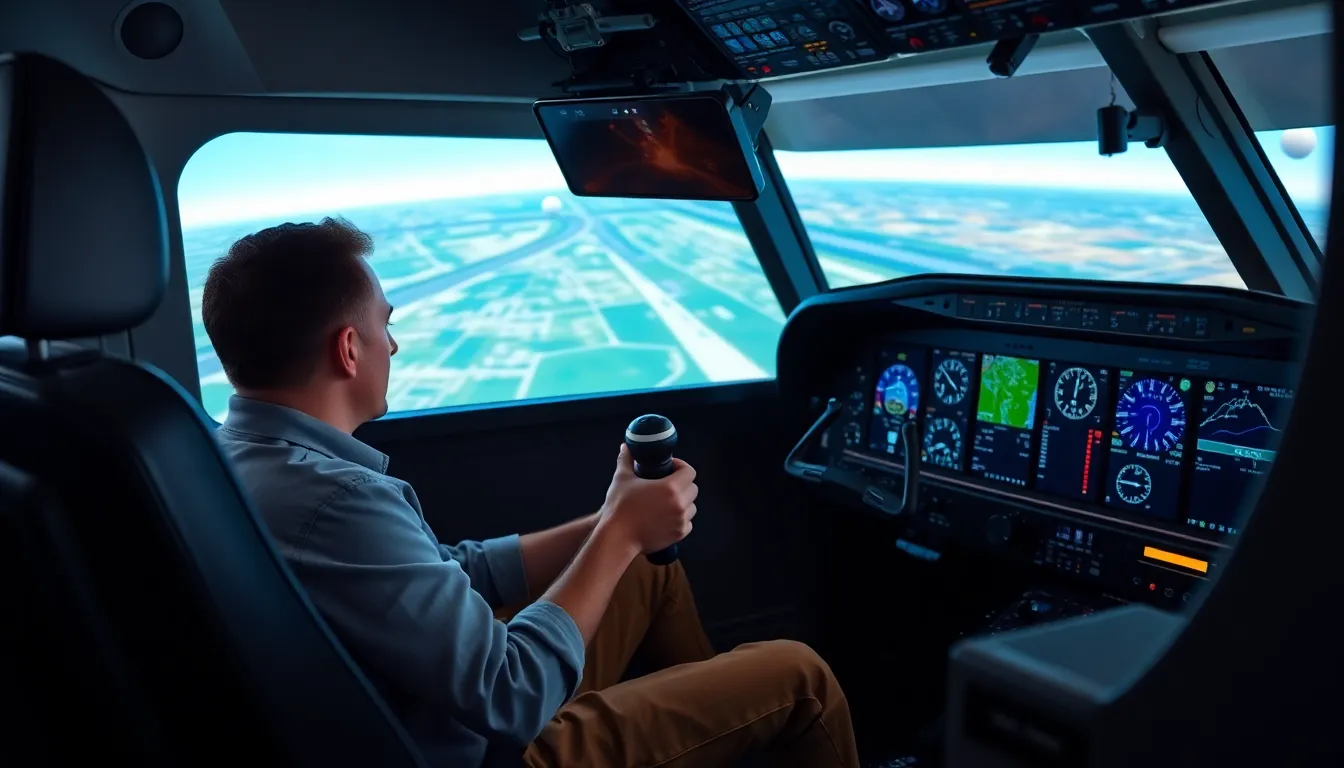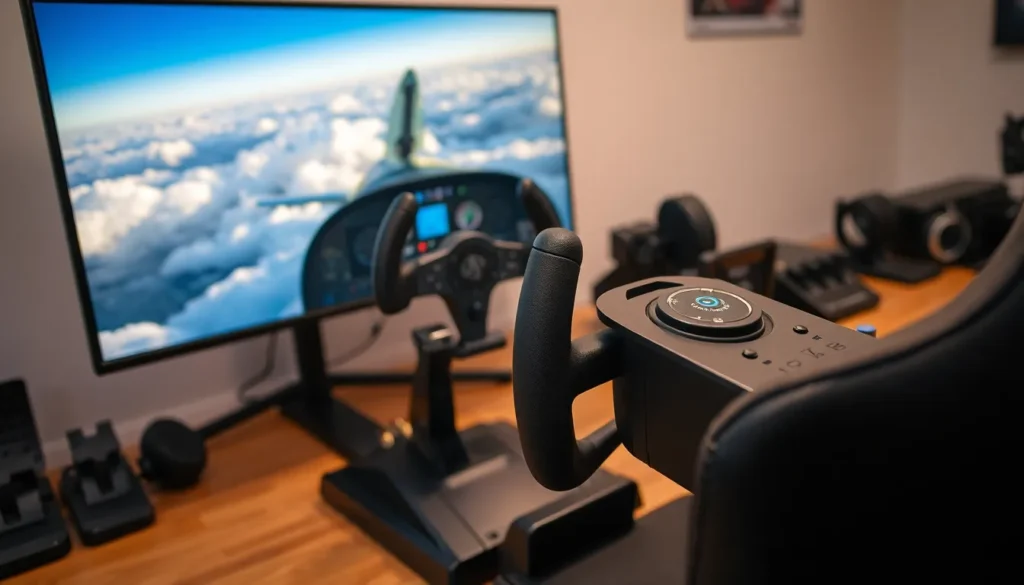For anyone dreaming of soaring through the skies without leaving their living room, flight simulator hardware for PC is the golden ticket. Imagine piloting a Boeing 747 while still in your pajamas—sounds like a win-win, right? With the right gear, you can turn your PC into a virtual cockpit that rivals the real deal, minus the turbulence and overpriced snacks.
But let’s face it, not all flight simulator hardware is created equal. Some gear can make you feel like a seasoned pilot, while others might just have you crash-landing in a virtual cornfield. Whether you’re a budding aviator or a seasoned pro, investing in quality hardware can elevate your flying experience from “meh” to “WOW!” Buckle up as we dive into the must-have gadgets that’ll have you taking off in style.
Flight Simulator Hardware For PC
Flight simulator hardware enhances the realism of virtual flying experiences. For those seeking immersion, a high-quality yoke or joystick stands out as essential equipment. Pilots often prefer yokes that mimic aircraft controls, providing necessary feedback during maneuvers. Joysticks, especially those equipped with throttle controls, cater to those looking for precision.
Furthermore, rudder pedals significantly improve the experience by offering realistic steering and brake functions. This combination enhances control during takeoffs and landings, making simulated flights more authentic. Gamers notice a marked difference in performance with dedicated pedals compared to using keyboard controls.
Monitors also play a critical role in creating an immersive environment. Wide screens or triple monitor setups allow for a broader field of view, emulating cockpit visibility. High-resolution displays increase detail, making scenery and aircraft interiors more lifelike.
In addition, headsets contribute to the depth of simulation. Quality headsets provide realistic soundscapes, from engine noise to radio communications. A good headset also aids in communication with virtual air traffic control, enhancing overall realism.
Finally, virtual reality (VR) headsets are transforming the flight simulation experience. Users report a heightened sense of presence while immersed in a 360-degree world. The combination of physical controller inputs with VR visual engagement elevates the simulation to new levels.
With the right flight simulator hardware, anyone can transform their PC into a realistic flying experience. Each component contributes uniquely to the overall simulation quality, making thoughtful choices crucial for enthusiasts and newcomers alike.
Essential Components for an Immersive Experience

Selecting the right hardware significantly enhances the flight simulation experience, creating a more authentic environment for users.
Joysticks and Yoke Controllers
High-quality joysticks and yoke controllers provide essential feedback during flight simulations. Joysticks are versatile, suitable for a range of aircraft, while yokes excel in simulating commercial flying. Both options offer precision, allowing for smoother maneuvers. Many models come with customizable buttons for added functionality, streamlining user interaction. Users benefit from selections that feature ergonomic designs, enhancing comfort during extended sessions. Investing in these controllers contributes directly to realism, making them indispensable for enthusiasts.
Rudder Pedals
Rudder pedals improve control during critical flight phases like takeoff and landing. These components allow pilots to manage yaw movements effectively, enhancing overall aircraft handling. Many rudder pedals offer adjustable resistance, which caters to individual preferences, ensuring a personalized experience. Users often notice a marked difference in performance when using quality pedals, especially in challenging flying conditions. Selecting a model with a solid build improves durability, making it a worthwhile investment in the long run.
Throttle Quadrants
Throttle quadrants facilitate precise power management throughout flights. They provide a logical layout for throttle levers, promoting accurate thrust control. Many throttle quadrants include features like integrated buttons for efficient command accessibility. Using these tools helps users simulate engine management realistically, contributing to authentic experiences. Ergonomics play a critical role in design, ensuring comfort and ease of use. Opting for a throttle quadrant enhances engagement, allowing pilots to focus on flying rather than managing controls.
Display Options for Flight Simulation
Display options significantly affect the flight simulation experience, influencing realism and immersion.
Monitors vs. Virtual Reality
Monitors provide a traditional display method, allowing easy setup and flexibility. A single wide monitor can enhance peripheral vision, while multiple monitors deliver an expansive field of view. Virtual reality headsets, on the other hand, immerse users in a 360-degree environment. They create a feeling of presence that traditional setups can’t match, making maneuvers more intuitive. Each option holds advantages, so choosing between monitors and VR depends on personal preferences and available space. Users seeking a fully immersive experience may favor VR, while those wanting a straightforward setup might opt for monitors.
Recommended Display Settings
Specific display settings can optimize the flight simulation experience. Setting the resolution to the highest native support enhances visual clarity. Adjusting field of view settings allows for a more realistic perspective. A refresh rate of 60 Hz or above ensures smooth visuals, critical during fast-paced maneuvers. Anti-aliasing techniques reduce jagged edges, improving overall image quality. It’s essential to balance graphical fidelity with performance, as too high settings can lead to lag. Testing settings to find a comfortable level without sacrificing responsiveness promotes enjoyment during long sessions.
Enhancing Sound and Communication
Sound and communication tools play a crucial role in flight simulation, creating an immersive environment. Quality headsets and microphones significantly enhance the experience by providing clear audio and effective communication.
Headsets and Microphones
Headsets and microphones improve communication clarity during flight simulations. Many options feature noise-canceling technology to block out background sounds, ensuring pilots can hear virtual air traffic control clearly. Models with integrated microphones offer convenient communication, allowing users to speak without reaching for separate devices. Comfortable designs keep players engaged during long sessions, preventing fatigue and distractions. High-fidelity audio provides realistic engine sounds, weather effects, and ambient noises. The immersive experience increases with sound accuracy, making simulations feel more authentic.
Sound Systems
Sound systems further enhance the overall simulation atmosphere. Multi-speaker setups deliver directional audio, creating a surround sound environment that mimics real aircraft acoustics. Systems with subwoofers amplify engine sounds and provide tactile feedback, making the experience more engaging. Various brands offer speaker configurations tailored for simulation, ensuring users find the right fit for their setups. Pre-configured sound profiles help optimize audio settings, boosting realism and immersion. Incorporating a good sound system can fully envelop the user in the experience, enhancing every aspect of flight.
Upgrades and Accessories
Upgrades and accessories greatly enhance the flight simulation experience. They provide opportunities for users to customize their setups according to personal preferences and ergonomic needs.
Customizing Your Setup
Customization greatly enhances comfort and efficiency during flight simulations. Choosing high-quality flight yokes, joysticks, or rudder pedals can significantly impact user performance. Adjustable features from different brands allow individuals to find the best fit for their hands and posture. Adding programmable buttons or switches facilitates quick access to essential functions, enhancing the overall flying experience. Users can also consider additional accessories like ergonomic chairs or desks designed for long sessions, promoting better posture and reducing fatigue.
Future-Proofing Your Hardware
Future-proofing ensures flight simulator hardware remains relevant as technology advances. Investing in modular components allows for easy upgrades without replacing the entire setup. High-quality monitors with extensive resolution capabilities support evolving graphic demands effectively. Compatibility with emerging technologies, such as new VR headsets or software updates, keeps the simulation experience fresh. Selecting devices known for their durability and performance longevity contributes to overall investment value, making upgrades seamless over time. Prioritizing hardware that supports a variety of simulation platforms adds versatility for users exploring different flying experiences.
Conclusion
Investing in quality flight simulator hardware can transform the simulation experience. With the right combination of yokes, joysticks, rudder pedals, and displays, users can achieve a level of realism that enhances every flight. Customization options allow for a personalized setup that meets individual preferences and ergonomic needs.
Moreover, the integration of advanced audio and communication tools further immerses users in the virtual cockpit. As technology evolves, choosing modular components ensures that setups remain relevant and adaptable. By making informed choices about hardware, both novices and seasoned pilots can enjoy a truly captivating flight simulation experience.


More Stories
Bundling with PC Components: The Secret to Easier Builds and Big Savings
What Is Hardware? Discover Its Essential Role in Modern Technology
PC Hardware Upgrade Scanner: Discover Your System’s Perfect Upgrade Path Today